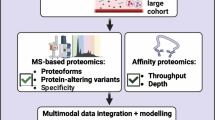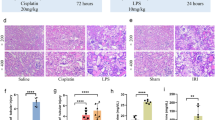Abstract
Babesia microti is a protozoan that mainly parasitizes rodent and human erythrocytes. B. microti infection can result in changes in the expression levels of various proteins in the host serum. To explore the mechanism underlying the regulation of serum proteins by the host during B. microti infection, this study used a data-independent acquisition (DIA) quantitative proteomic approach to perform comprehensive quantitative proteomic analysis on the serum of B. microti-infected mice. We identified and analysed 333 serum proteins during the infectious stage and recovery stage within 30 days of infection by B. microti in mice. Through quantitative analysis, we found 57 proteins differentially expressed in the infection stage and 69 proteins differentially expressed in the recovery stage. Bioinformatics analysis revealed that these differentially expressed proteins were mainly concentrated in organelles, cell parts, and extracellular regions that are mainly involved in immune system, metabolic, and cellular processes. Additionally, the differentially expressed proteins mainly had catalytic activity. Kyoto Encyclopedia of Genes and Genome (KEGG) pathway analysis showed that many of the differentially expressed proteins participate in the complement and coagulation cascade reaction, including complement C3, complement FP, and coagulation factor XII. The results of this study can provide more information for the selection of biomarkers for the early clinical monitoring of babesiosis and help in the treatment of babesiosis.






Similar content being viewed by others
References
Lobo CA, Cursino-Santos JR, Alhassan A, Rodrigues M (2013) Babesia: an emerging infectious threat in transfusion medicine. PLoS Pathog 9:e1003387. https://doi.org/10.1371/journal.ppat.1003387
Vannier EG, Diuk-Wasser MA, Ben Mamoun C, Krause PJ (2015) Babesiosis. Infect Dis Clin North Am 29:357–370. https://doi.org/10.1016/j.idc.2015.02.008
Vannier E, Krause PJ (2012) Human babesiosis. N Engl J Med 366:2397–2407. https://doi.org/10.1056/NEJMra1202018
Kules J, Mrljak V, Baric Rafaj R, Selanec J, Burchmore R, Eckersall PD (2014) Identification of serum biomarkers in dogs naturally infected with Babesia canis canis using a proteomic approach. BMC Vet Res 10:111. https://doi.org/10.1186/1746-6148-10-111
Ray S, Srivastava R, Tripathi K, Vaibhav V, Patankar S, Srivastava S (2012) Serum proteome changes in dengue virus-infected patients from a dengue-endemic area of India: towards new molecular targets? OMICS 16:527–536. https://doi.org/10.1089/omi.2012.0037
Xu B, Liu XF, Cai YC, Huang JL, Zhang RX, Chen JH, Cheng XJ, Zhou X, Xu XN, Zhou Y, Zhang T, Chen SB, Li J, Wu QF, Sun CS, Fu YF, Chen JX, Zhou XN, Hu W (2018) Screening for biomarkers reflecting the progression of Babesia microti infection. Parasites Vectors 11:379. https://doi.org/10.1186/s13071-018-2951-0
Wang M, Hu Y, Li M, Xu Q, Zhang X, Wang X, Xue X, Xiao Q, Liu J, Wang H (2020) A proteomics analysis of the ovarian development in females of Haemaphysalis longicornis. Exp Appl Acarol 80:289–309. https://doi.org/10.1007/s10493-020-00469-3
Ma J, Chen T, Wu SF, Yang CY, Bai MZ, Shu KX, Li KL, Zhang GQ, Jin Z, He FC, Hermjakob H, Zhu YP (2019) iProX: an integrated proteome resource. Nucleic Acids Res 47:D1211–D1217. https://doi.org/10.1093/nar/gky869
Jung JY, Kwak YH, Kim KS, Kwon WY, Suh GJ (2015) Change of hemopexin level is associated with the severity of sepsis in endotoxemic rat model and the outcome of septic patients. J Crit Care 30:525–530. https://doi.org/10.1016/j.jcrc.2014.12.009
Garland P, Durnford AJ, Okemefuna AI, Dunbar J, Nicoll JA, Galea J, Boche D, Bulters DO, Galea I (2016) Heme-hemopexin scavenging is active in the brain and associates with outcome after subarachnoid hemorrhage. Stroke 47:872–876. https://doi.org/10.1161/STROKEAHA.115.011956
Wei Q, Tsuji M, Zamoto A, Kohsaki M, Matsui T, Shiota T, Telford SR, Ishihara C (2001) Human babesiosis in Japan: isolation of Babesia microti-like parasites from an asymptomatic transfusion donor and from a rodent from an area where babesiosis is endemic. J Clin Microbiol 39:2178–2183. https://doi.org/10.1128/JCM.39.6.2178-2183.2001
Honey K, Rudensky AY (2003) Lysosomal cysteine proteases regulate antigen presentation. Nat Rev Immunol 3:472–482. https://doi.org/10.1038/nri1110
Aggarwal N, Sloane BF (2014) Cathepsin B: multiple roles in cancer. Proteomics Clin Appl 8:427–437. https://doi.org/10.1002/prca.201300105
Choi-Miura NH (2004) Novel human plasma proteins, IHRP (acute phase protein) and PHBP (serine protease), which bind to glycosaminoglycans. Curr Med Chem Cardiovasc Hematol Agents 2:239–248. https://doi.org/10.2174/1568016043356327
Zhuo L, Kimata K (2008) Structure and function of inter-alpha-trypsin inhibitor heavy chains. Connect Tissue Res 49:311–320. https://doi.org/10.1080/03008200802325458
Bajic G, Degn SE, Thiel S, Andersen GR (2015) Complement activation, regulation, and molecular basis for complement-related diseases. EMBO J 34:2735–2757. https://doi.org/10.15252/embj.201591881
Muller-Eberhard HJ (1985) The killer molecule of complement. J Investig Dermatol 85:47s–52s. https://doi.org/10.1111/1523-1747.ep12275445
Ursini F, Russo E, Mauro D, Abenavoli L, Ammerata G, Serrao A, Grembiale RD, De Sarro G, Olivieri I, D’Angelo S (2017) Complement C3 and fatty liver disease in rheumatoid arthritis patients: a cross-sectional study. Eur J Clin Investig 47:728–735. https://doi.org/10.1111/eci.12798
Okla H, Jasik KP, Slodki J, Rozwadowska B, Slodki A, Jurzak M, Pierzchala E (2014) Hepatic tissue changes in rats due to chronic invasion of Babesia microti. Folia Biol (Krakow) 62:353–359. https://doi.org/10.3409/fb62_4.353
Fearon DT, Austen KF (1975) Properdin: initiation of alternative complement pathway. Proc Natl Acad Sci USA 72:3220–3224. https://doi.org/10.1073/pnas.72.8.3220
Blatt AZ, Pathan S, Ferreira VP (2016) Properdin: a tightly regulated critical inflammatory modulator. Immunol Rev 274:172–190. https://doi.org/10.1111/imr.12466
Markiewski MM, Nilsson B, Ekdahl KN, Mollnes TE, Lambris JD (2007) Complement and coagulation: strangers or partners in crime? Trends Immunol 28:184–192. https://doi.org/10.1016/j.it.2007.02.006
Ritis K, Doumas M, Mastellos D, Micheli A, Giaglis S, Magotti P, Rafail S, Kartalis G, Sideras P, Lambris JD (2006) A novel C5a receptor-tissue factor cross-talk in neutrophils links innate immunity to coagulation pathways. J Immunol 177:4794–4802. https://doi.org/10.4049/jimmunol.177.7.4794
Ueda Y, Miwa T, Gullipalli D, Sato S, Ito D, Kim H, Palmer M, Song WC (2018) Blocking properdin prevents complement-mediated hemolytic uremic syndrome and systemic thrombophilia. J Am Soc Nephrol 29:1928–1937. https://doi.org/10.1681/ASN.2017121244
Kimura Y, Zhou L, Miwa T, Song WC (2010) Genetic and therapeutic targeting of properdin in mice prevents complement-mediated tissue injury. J Clin Investig 120:3545–3554. https://doi.org/10.1172/jci41782
Miwa T, Sato S, Gullipalli D, Nangaku M, Song WC (2013) Blocking properdin, the alternative pathway, and anaphylatoxin receptors ameliorates renal ischemia-reperfusion injury in decay-accelerating factor and CD59 double-knockout mice. J Immunol 190:3552–3559. https://doi.org/10.4049/jimmunol.1202275
Wang Y, Miwa T, Ducka-Kokalari B, Redai IG, Sato S, Gullipalli D, Zangrilli JG, Haczku A, Song WC (2015) Properdin contributes to allergic airway inflammation through local C3a generation. J Immunol 195:1171–1181. https://doi.org/10.4049/jimmunol.1401819
Harpel PC, Cooper NR (1975) Studies on human plasma C1 inactivator-enzyme interactions. I. Mechanisms of interaction with C1s, plasmin, and trypsin. J Clin Investig 55:593–604. https://doi.org/10.1172/JCI107967
Matsushita M, Thiel S, Jensenius JC, Terai I, Fujita T (2000) Proteolytic activities of two types of mannose-binding lectin-associated serine protease. J Immunol 165:2637–2642. https://doi.org/10.4049/jimmunol.165.5.2637
de Agostini A, Lijnen HR, Pixley RA, Colman RW, Schapira M (1984) Inactivation of factor XII active fragment in normal plasma. Predominant role of C-1-inhibitor. J Clin Investig 73:1542–1549. https://doi.org/10.1172/JCI111360
Nickel KF, Long AT, Fuchs TA, Butler LM, Renne T (2017) Factor XII as a therapeutic target in thromboembolic and inflammatory diseases. Arterioscler Thromb Vasc Biol 37:13–20. https://doi.org/10.1161/ATVBAHA.116.308595
Marais AD (2019) Apolipoprotein E in lipoprotein metabolism, health and cardiovascular disease. Pathology 51:165–176. https://doi.org/10.1016/j.pathol.2018.11.002
Boisvert WA, Spangenberg J, Curtiss LK (1995) Treatment of severe hypercholesterolemia in apolipoprotein E-deficient mice by bone marrow transplantation. J Clin Investig 96:1118–1124. https://doi.org/10.1172/JCI118098
Ginsberg HN, Le NA, Goldberg IJ, Gibson JC, Rubinstein A, Wang-Iverson P, Norum R, Brown WV (1986) Apolipoprotein B metabolism in subjects with deficiency of apolipoproteins CIII and AI. Evidence that apolipoprotein CIII inhibits catabolism of triglyceride-rich lipoproteins by lipoprotein lipase in vivo. J Clin Investig 78:1287–1295. https://doi.org/10.1172/JCI112713
Aalto-Setala K, Fisher EA, Chen X, Chajek-Shaul T, Hayek T, Zechner R, Walsh A, Ramakrishnan R, Ginsberg HN, Breslow JL (1992) Mechanism of hypertriglyceridemia in human apolipoprotein (apo) CIII transgenic mice. Diminished very low density lipoprotein fractional catabolic rate associated with increased apo CIII and reduced apo E on the particles. J Clin Investig 90:1889–1900. https://doi.org/10.1172/JCI116066
Clavey V, Lestavel-Delattre S, Copin C, Bard JM, Fruchart JC (1995) Modulation of lipoprotein B binding to the LDL receptor by exogenous lipids and apolipoproteins CI, CII, CIII, and E. Arterioscler Thromb Vasc Biol 15:963–971. https://doi.org/10.1161/01.atv.15.7.963
Brown RJ, Lagor WR, Sankaranaravanan S, Yasuda T, Quertermous T, Rothblat GH, Rader DJ (2010) Impact of combined deficiency of hepatic lipase and endothelial lipase on the metabolism of both high-density lipoproteins and apolipoprotein B-containing lipoproteins. Circ Res 107:357–364. https://doi.org/10.1161/CIRCRESAHA.110.219188
Ooi EM, Watts GF, Chan DC, Chen MM, Nestel PJ, Sviridov D, Barrett PH (2008) Dose-dependent effect of rosuvastatin on VLDL-apolipoprotein C-III kinetics in the metabolic syndrome. Diabetes Care 31:1656–1661. https://doi.org/10.2337/dc08-0358
Mendivil CO, Rimm EB, Furtado J, Chiuve SE, Sacks FM (2011) Low-density lipoproteins containing apolipoprotein C-III and the risk of coronary heart disease. Circulation 124:2065–2072. https://doi.org/10.1161/CIRCULATIONAHA.111.056986
Pollin TI, Damcott CM, Shen H, Ott SH, Shelton J, Horenstein RB, Post W, McLenithan JC, Bielak LF, Peyser PA, Mitchell BD, Miller M, O’Connell JR, Shuldiner AR (2008) A null mutation in human APOC3 confers a favorable plasma lipid profile and apparent cardioprotection. Science 322:1702–1705. https://doi.org/10.1126/science.1161524
TG and HDL Working Group of the Exome Sequencing Project, National Heart, Lung, and Blood Institute, Crosby J, Peloso GM, Auer PL, Crosslin DR, Stitziel NO, Lange LA, Lu Y, Tang ZZ, Zhang H, Hindy G, Masca N, Stirrups K, Kanoni S, Do R, Jun G, Hu Y, Kang HM, Xue C, Goel A, Farrall M, Duga S, Merlini PA, Asselta R, Girelli D, Olivieri O, Martinelli N, Yin W, Reilly D, Speliotes E, Fox S, Hveem K, Holmen OL, Nikpay M, Farlow DN, Assimes TL, Franceschini N, Robinson J, North KE, Martin LW, DePristo M, Gupta N, Escher SA, Jansson JH, Van Zuydam N, Palmer CN, Wareham N, Koch W, Meitinger T, Peters A, Lieb W, Erbel R, Konig IR, Kruppa J, Degenhardt F, Gottesman O, Bottinger EP, O’Donnell CJ, Psaty BM, Ballantyne CM, Abecasis G, Ordovas JM, Melander O, Watkins H, Orho-Melander M, Ardissino D, Loos RJ, McPherson R, Willer CJ, Erdmann J, Hall AS, Samani NJ, Deloukas P, Schunkert H, Wilson JG, Kooperberg C, Rich SS, Tracy RP, Lin DY, Altshuler D, Gabriel S, Nickerson DA, Jarvik GP, Cupples LA, Reiner AP, Boerwinkle E, Kathiresan S (2014) Loss-of-function mutations in APOC3, triglycerides, and coronary disease. N Engl J Med 371:22–31. https://doi.org/10.1056/NEJMoa1307095
Brouillette CG, Anantharamaiah GM, Engler JA, Borhani DW (2001) Structural models of human apolipoprotein A-I: a critical analysis and review. Biochim Biophys Acta 1531:4–46. https://doi.org/10.1016/s1388-1981(01)00081-6
Duffy D, Rader DJ (2009) Update on strategies to increase HDL quantity and function. Nat Rev Cardiol 6:455–463. https://doi.org/10.1038/nrcardio.2009.94
Cho KH, Park SH, Han JM, Kim HC, Choi YK, Choi I (2006) ApoA-I mutants V156K and R173C promote anti-inflammatory function and antioxidant activities. Eur J Clin Investig 36:875–882. https://doi.org/10.1111/j.1365-2362.2006.01737.x
Cho KH (2011) Enhanced delivery of rapamycin by V156K-apoA-I high-density lipoprotein inhibits cellular proatherogenic effects and senescence and promotes tissue regeneration. J Gerontol A Biol Sci Med Sci 66:1274–1285. https://doi.org/10.1093/gerona/glr169
Ferretti G, Bacchetti T, Bicchiega V, Curatola G (2002) Effect of human Apo AIV against lipid peroxidation of very low density lipoproteins. Chem Phys Lipids 114:45–54. https://doi.org/10.1016/s0009-3084(01)00201-8
Acknowledgement
Thanks the Institute of Laboratory Animal Sciences, Chinese Academy of Medical Sciences for donating B. microti in this experiment.
Funding
This work was supported by the Natural Science Fund for Distinguished Young Scholars of Hebei Normal University (No. L2017J04).
Author information
Authors and Affiliations
Contributions
HW designed experiments and wrote the initial manuscript. XW, SR, XY, AM, XX performed experiments. ML, HL, XZ prepared figures. JL designed experiments and correction of the manuscript.
Corresponding authors
Ethics declarations
Conflict of interest
The authors declare that they have no conflict of interest.
Additional information
Publisher's Note
Springer Nature remains neutral with regard to jurisdictional claims in published maps and institutional affiliations.
Rights and permissions
About this article
Cite this article
Wang, X., Ren, S., Yang, X. et al. Exploration of Serum Marker Proteins in Mice Induced by Babesia microti Infection Using a Quantitative Proteomic Approach. Protein J 40, 119–130 (2021). https://doi.org/10.1007/s10930-020-09952-7
Accepted:
Published:
Issue Date:
DOI: https://doi.org/10.1007/s10930-020-09952-7




